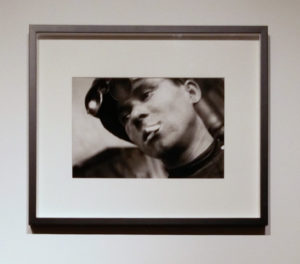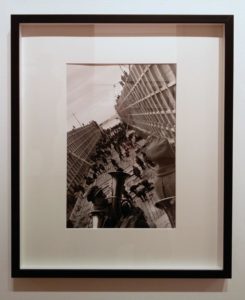 Coming from painting and sculpture, the constructivist Alexander Rodchenko stood for the incorporation of arts into daily life. Therefore, in 1920s he was occupied with graphic, design and handicraft. At that time, he also started to experiment with photomontages using pre-existing pictures, inspired by the German Dadaists. Soon, in 1924 he started himself to take photographs. Not surprisingly with regard to his artistic past and the soviet modernism with the credo of production and all related work process as future-orientation for the young socialistic state, Rodchenko took pictures of production sites and workers.
Coming from painting and sculpture, the constructivist Alexander Rodchenko stood for the incorporation of arts into daily life. Therefore, in 1920s he was occupied with graphic, design and handicraft. At that time, he also started to experiment with photomontages using pre-existing pictures, inspired by the German Dadaists. Soon, in 1924 he started himself to take photographs. Not surprisingly with regard to his artistic past and the soviet modernism with the credo of production and all related work process as future-orientation for the young socialistic state, Rodchenko took pictures of production sites and workers.
In 1929, he shot series of the AMO Automobile Plant, the Electric Lamp Plant and the MoGES (Moscow Electric Power Station), all in Moscow. The Mechanised Canteen in the same city (1929-32) and the Metallurgical Plant Serp I Molot (1930) were also motifs like the Vakhtan Timber Mill in the Nizhny Novgorod region (1931). Furthermore, Rodchenko took pictures of construction sites like the Park of Culture and the laying of asphalt at the Leningrad Highway, just as the newspaper GUDOK and the Radio Centre Moscow were in his focus. Finally, in 1933 the avant-gardist was sent to document the construction of the White Sea-Baltic Canal in Karelia.
 All these sites represent the emerging Soviet Republic. Even though, the White Sea-Baltic Canal was built by prisoners of one of the largest Gulags in the U.S.S.R. The rise of Joseph Stalin with his repressive politic sounds from the background. Due to the changing political requirements for the artistic practice in the 1930s, Alexandre Rodchenko turned towards reportages and sports photography. As artist, he returned more and more to painting and abandoned photography in 1942 completely.
All these sites represent the emerging Soviet Republic. Even though, the White Sea-Baltic Canal was built by prisoners of one of the largest Gulags in the U.S.S.R. The rise of Joseph Stalin with his repressive politic sounds from the background. Due to the changing political requirements for the artistic practice in the 1930s, Alexandre Rodchenko turned towards reportages and sports photography. As artist, he returned more and more to painting and abandoned photography in 1942 completely.
Remaining are the dynamic forward-orientated images as witness of the Russian avant-garde in the beginnings of the Soviet Union. Thanks to the collection of the Multimedia Art Museum / Moscow House of Photography, it was possible to see some of them during the Foto/Industria.
Although taken around 90 years ago, the photos have nothing lost of their energetic radiance. They often have an uncommon perspective: shot in aerial view or from below, from the back or oblique. Diagonal or curved lines give a structure to the image plane. Objects are cut, so that they seem to want to burst out of the photo. One might feel the altitude in which the electrician is working or the vibrations of the road graders. The printing plate for the GUDOK journal appears in glistening light like a divine promise and machine parts are arranged that they become an abstract picture.
Rodchenko worked with stylistic elements to increase the dynamic of his pictures. Lee Friedlander took circa 50 years later as well photos “At Work”. They are not only the expression of another artistic style; they also illustrate another culture and the changings of labour.
Read more:
Foto/Industria: views on labour and industrial development
Alexander Rodchenko – The industrial World
Mimmo Jodice – The militant Years
Josef Koudelka – Industrial Landscapes























